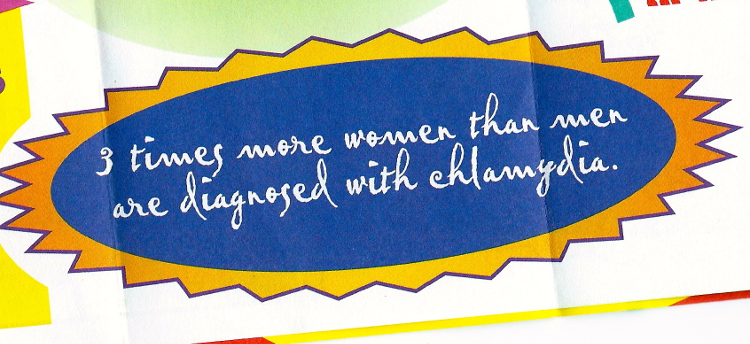
I was recently asked to present at a conference of teens teaching other teens about STIs. While I was impressed with the few students who led the workshops, I was saddened to see the lack of basic STI knowledge in the rest of the student body.
Many of you have told me that you don’t have health classes in school. Some of you who have taken health have told me that you’re not learning enough facts that will keep you safe. With the absence of comprehensive sexual health education in too many schools today, some teens search for answers online.
Please beware: some of what’s out there may not be correct or useful information.
BUT…I’m here to help guide you in the right direction!
Here’s a great post on chlamydia that IS useful! It’s from KidsHealth.org. And here’s the full link, if you want to search through their site:
What is it?
Chlamydia (pronounced: kluh-MID-ee-uh) is a sexually transmitted disease (STD) caused by bacteria called Chlamydia trachomatis. Although you may not be familiar with its name, chlamydia is one of the most common STDs. Because there often aren’t any symptoms, though, lots of people can have chlamydia and not know it.
The bacteria can move from one person to another through sexual intercourse, and possibly through oral-genital contact. If someone touches bodily fluids that contain the bacteria and then touches his or her eye, a chlamydial eye infection (chlamydial conjunctivitis) is possible. Chlamydia also can be passed from a mother to her baby while the baby is being delivered. This can cause pneumonia and conjuntivitis, which can become very serious for the baby if it’s not treated. You can’t catch chlamydia from a towel, doorknob, or toilet seat.
How Does a Girl Know She Has It?
It can be difficult for a girl to know whether she has chlamydia because most girls don’t have any symptoms. Because of this, it’s very important to see a doctor at least once a year if you are sexually active. Your doctor can tell you about how to test for chlamydia, even if you don’t have any symptoms.
Much less often, symptoms are present and may cause an unusual vaginal discharge or pain during urination. Some girls with chlamydia also have pain in their lower abdomens, pain during sexual intercourse, or bleeding between menstrual periods. Sometimes a chlamydia infection can cause a mild fever, muscle aches, or headache.
How Does a Guy Know He Has It?
A guy can also have a difficult time recognizing that he has chlamydia and should be tested by a doctor at least once a year if he is sexually active.
When symptoms are there, guys may have a discharge from the tip of the penis (the urethra — where urine comes out), or itching or burning sensations around the penis. Rarely, the testicles may become swollen. Many times, a guy with chlamydia may have few or no symptoms, so he might not even know he has it.
When Do Symptoms Appear?
Someone who has contracted chlamydia may see symptoms a week later. In some people, the symptoms take up to 3 weeks to appear, and many people never develop any symptoms. 75% of women and 50% of men will show no symptoms.
What Can Happen?
If left untreated in girls, chlamydia can cause an infection of the urethra (where urine comes out) and inflammation (swelling and soreness caused by the infection) of the cervix. It can also lead to pelvic inflammatory disease (PID), which is an infection of the uterus, ovaries, and/or fallopian tubes. PID can cause infertility and ectopic (tubal) pregnancies later in life.
If left untreated in guys, chlamydia can cause inflammation of the urethra and epididymis (the structure attached to the testicle that helps transport sperm).
How Is It Treated?
If you think you may have chlamydia or if you have had a partner who may have chlamydia, you need to see your family doctor, adolescent doctor, or gynecologist. Some local health clinics, such as Planned Parenthood, can also test and treat people for chlamydia.
If the infection occurs through vaginal or anal intercourse, doctors usually diagnose chlamydia by testing a person’s urine or taking a tissue sample from the anus or the vagina. If the infection occurs through oral sex, doctors will take a culture from the back of the throat, whether or not there are symptoms.
If you have been exposed to chlamydia or are diagnosed with chlamydia, the doctor will prescribe antibiotics, which should clear up the infection in 7 to 10 days.
Anyone with whom you’ve had sex will also need to be tested and treated for chlamydia because that person may be infected but not have any symptoms. This includes any sexual partners in the last 2 months or your last sexual partner if it has been more than 2 months since your last sexual experience. It is very important that someone with a chlamydia infection abstain from having sex until they and their partner have been treated.
If a sexual partner has chlamydia, quick treatment will reduce his or her risk of complications and will lower your chances of being reinfected if you have sex with that partner again. (You can become infected with chlamydia again even after you have been treated because having chlamydia does not make you immune to it.)
It’s better to prevent chlamydia than to treat it, and the only way to completely prevent the infection is to abstain from all types of sexual intercourse. If you do have sex, use a latex condom every time. This is the only birth control method that will help prevent chlamydia.
Reviewed by: Nicole A. Green, MD
Date reviewed: March 2013
Date reviewed: March 2013
DISCLAIMER: The information contained in this post is intended to inform readers and is not intended to replace specific advice from a health care professional.

Leave A Comment